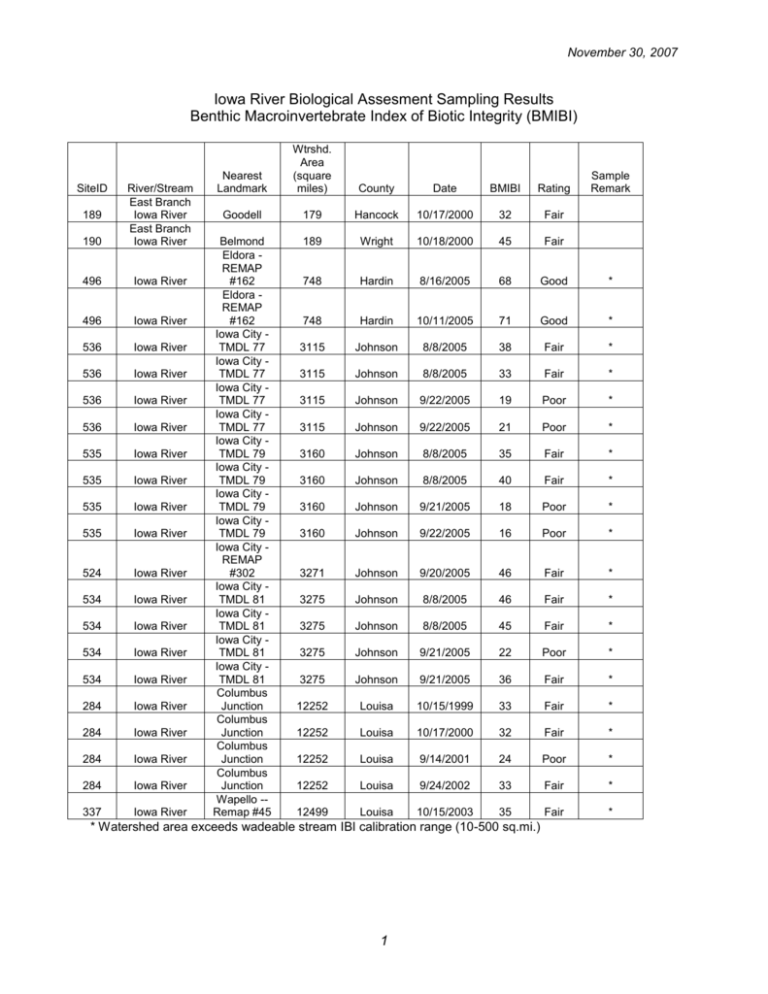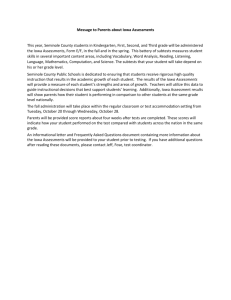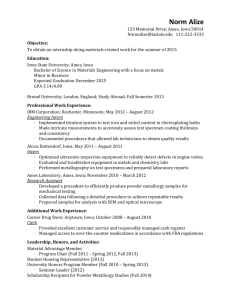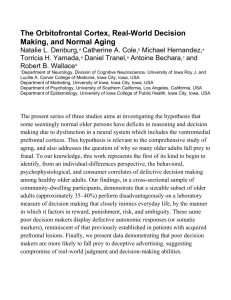and the Fish Index of Biotic Integrity (FIBI)
advertisement

November 30, 2007 Iowa River Biological Assesment Sampling Results Benthic Macroinvertebrate Index of Biotic Integrity (BMIBI) SiteID 190 River/Stream East Branch Iowa River East Branch Iowa River 496 Iowa River 496 Iowa River 536 Iowa River 536 Iowa River 536 Iowa River 536 Iowa River 535 Iowa River 535 Iowa River 535 Iowa River 535 Iowa River 524 Iowa River 534 Iowa River 534 Iowa River 534 Iowa River 534 Iowa River 284 Iowa River 284 Iowa River 284 Iowa River 284 Iowa River 337 Iowa River 189 Nearest Landmark Wtrshd. Area (square miles) County Date BMIBI Rating Goodell 179 Hancock 10/17/2000 32 Fair Belmond Eldora REMAP #162 Eldora REMAP #162 Iowa City TMDL 77 Iowa City TMDL 77 Iowa City TMDL 77 Iowa City TMDL 77 Iowa City TMDL 79 Iowa City TMDL 79 Iowa City TMDL 79 Iowa City TMDL 79 Iowa City REMAP #302 Iowa City TMDL 81 Iowa City TMDL 81 Iowa City TMDL 81 Iowa City TMDL 81 Columbus Junction Columbus Junction Columbus Junction Columbus Junction Wapello -Remap #45 189 Wright 10/18/2000 45 Fair 748 Hardin 8/16/2005 68 Good * 748 Hardin 10/11/2005 71 Good * 3115 Johnson 8/8/2005 38 Fair * 3115 Johnson 8/8/2005 33 Fair * 3115 Johnson 9/22/2005 19 Poor * 3115 Johnson 9/22/2005 21 Poor * 3160 Johnson 8/8/2005 35 Fair * 3160 Johnson 8/8/2005 40 Fair * 3160 Johnson 9/21/2005 18 Poor * 3160 Johnson 9/22/2005 16 Poor * 3271 Johnson 9/20/2005 46 Fair * 3275 Johnson 8/8/2005 46 Fair * 3275 Johnson 8/8/2005 45 Fair * 3275 Johnson 9/21/2005 22 Poor * 3275 Johnson 9/21/2005 36 Fair * 12252 Louisa 10/15/1999 33 Fair * 12252 Louisa 10/17/2000 32 Fair * 12252 Louisa 9/14/2001 24 Poor * 12252 Louisa 9/24/2002 33 Fair * 12499 Louisa 10/15/2003 35 Fair * * Watershed area exceeds wadeable stream IBI calibration range (10-500 sq.mi.) 1 Sample Remark November 30, 2007 Iowa River Biological Assesment Sampling Results Fish Index of Biotic Integrity (FIBI) SiteID 190 River/Stream East Branch Iowa River East Branch Iowa River East Branch Iowa River 496 Iowa River 496 Iowa River 536 Iowa River 536 Iowa River 535 Iowa River 535 Iowa River 524 Iowa River 534 Iowa River 534 Iowa River 337 Iowa River 189 190 Nearest Landmark County Wtrshd. Area (square miles) Goodell Hancock 179 10/17/2000 29 Fair Belmond Wright 189 10/18/2000 39 Fair Belmond Eldora REMAP #162 Eldora REMAP #162 Iowa City TMDL 77 Iowa City TMDL 77 Iowa City TMDL 79 Iowa City TMDL 79 Iowa City REMAP #302 Iowa City TMDL 81 Iowa City TMDL 81 Wapello -Remap #45 Wright 189 8/25/2005 30 Fair Hardin 748 8/16/2005 63 Good * Hardin 748 10/11/2005 71 Excellent * Johnson 3115 8/9/2005 6 Poor * Johnson 3115 9/22/2005 11 Poor * Johnson 3160 8/9/2005 7 Poor * Johnson 3160 9/21/2005 9 Poor * Johnson 3271 9/20/2005 22 Poor * Johnson 3275 8/8/2005 6 Poor * Johnson 3275 9/21/2005 13 Poor * Louisa 12499 9/26/2002 39 Fair * Date FIBI Rating * Watershed area exceeds wadeable stream IBI calibration range (10-500 sq.mi.) 2 Sample Remark November 30, 2007 Data metrics of the Benthic Macroinvertebrate Index of Biotic Integrity (BMIBI) and the Fish Index of Biotic Integrity (FIBI). BMIBI Metrics MH*-taxa richness SH*-taxa richness MH-EPT richness SH-EPT richness MH-sensitive taxa % 3-dominant taxa (SH) Biotic index (SH) % EPT (SH) % Chironomidae (SH) % Ephemeroptera (SH) % Scrapers (SH) % Dom. functional feeding group (SH) FIBI Metrics # native fish species # sucker species # sensitive species # benthic invertivore species % 3-dominant fish species % benthic invertivores % omnivores % top carnivores % simple lithophil spawners fish assemblage tolerance index adjusted catch per unit effort % fish with DELTs * MH, Multi-habitat sample; SH, Standard-habitat sample. 3 November 30, 2007 Qualitative scoring guidelines for the BMIBI. Biological Condition Rating 76-100 (Excellent) 56-75 (Good) 31-55 (Fair) 0-30 (Poor) Characteristics of Benthic Macroinvertebrate Assemblage High numbers of taxa are present, including many sensitive species. EPT taxa are very diverse and dominate the benthic macroinvertebrate assemblage in terms of abundance. Habitat and trophic specialists, such as scraper organisms, are present in good numbers. All major functional feeding groups (ffg) are represented, and no particular ffg is excessively dominant. The assemblage is diverse and reasonably balanced with respect to the abundance of each taxon. Taxa richness is slightly reduced from optimum levels; however, good numbers of taxa are present, including several sensitive species. EPT taxa are fairly diverse and numerically dominate the assemblage. The mostsensitive taxa and some habitat specialists may be reduced in abundance or absent. The assemblage is reasonably balanced, with no taxon excessively dominant. One ffg, often collector-filterers or collector-gatherers, may be somewhat dominant over other ffgs. Levels of total taxa richness and EPT taxa richness are noticeably reduced from optimum levels; sensitive species and habitat specialists are rare; EPT taxa still may be dominant in abundance; however, the most-sensitive EPT taxa have been replaced by more-tolerant EPT taxa. The assemblage is not balanced; just a few taxa contribute to the majority of organisms. Collectorfilterers or collector-gatherers often comprise more than 50% of the assemblage; representation among other ffgs is low or absent. Total taxa richness and EPT taxa richness are low. Sensitive species and habitat specialists are rare or absent. EPT taxa are no longer numerically dominant. A few tolerant organisms typically dominate the assemblage. Trophic structure is unbalanced; collector-filterers or collector-gatherers are often excessively dominant; usually some ffgs are not represented. Abundance of organisms is often low. 4 November 30, 2007 Qualitative scoring guidelines for the FIBI. Biological Condition Rating 71-100 (Excellent) 51-70 (Good) 26-50 (Fair) 0-25 (Poor) Characteristics of Fish Assemblage Fish (excluding tolerant species) are fairly abundant or abundant. A high number of native species are present, including many long-lived, habitat specialist, and sensitive species. Sensitive fish species and species of intermediate pollution tolerance are numerically dominant. The three most abundant fish species typically comprise 50% or less of the total number of fish. Top carnivores are usually present in appropriate numbers and multiple life stages. Habitat specialists, such as benthic invertivore and simple lithophilous spawning fish are present at near optimal levels. Fish condition is good; typically less than 1% of total fish exhibit external anomalies associated with disease or stress. Fish (excluding tolerant species) are fairly abundant to very abundant. If high numbers are present, intermediately tolerant species or tolerant species are usually dominant. A moderately high number of fish species belonging to several families are present. The three most abundant fish species typically comprise two-thirds or less of the total number of fish. Several long-lived species and benthic invertivore species are present. One or more sensitive species are usually present. Top carnivore species are usually present in low numbers and often one or more life stages are missing. Species that require silt-free, rock substrate for spawning or feeding are present in low proportion to the total number of fish. Fish condition is good; typically less than 1% of the total number of fish exhibits external anomalies associated with disease or stress. Fish abundance ranges from lower than average to very abundant. If fish are abundant, tolerant species are usually dominant. Native fish species usually equal ten or more species. The three most abundant species typically comprise two-thirds or more of the total number of fish. One or more sensitive species, long-lived fish species or benthic habitat specialists such as suckers (Catostomidae) are present. Top carnivore species are often, but not always present in low abundance. Species that are able to utilize a wide range of food items including plant, animal and detritus are usually more common than specialized feeders, such as benthic invertivore fish. Species that require silt-free, rock substrate for spawning or feeding are typically rare or absent. Fish condition is usually good; however, elevated levels of fish exhibiting external anomalies associated with disease or stress are not unusual. Fish abundance is usually lower than normal or, if fish are abundant, the assemblage is dominated by a few or less tolerant species. The number of native fish species present is low. Sensitive species and habitat specialists are absent or extremely rare. The fish assemblage is dominated by just a few ubiquitous species that are tolerant of wide-ranging water quality and habitat conditions. Pioneering, introduced and/or short-lived fish species are typically the most abundant types of fish. Elevated levels of fish with external physical anomalies are more likely to occur. 5 November 30, 2007 Iowa River Bioassessment Sampling Sites 6









